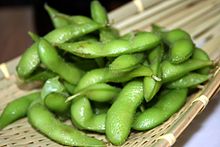Edamame
This article needs additional citations for verification. (December 2011) |
| Edamame | |
|---|---|

| |
| Boiled green vegetable soybeans in the pod. | |
| Scientific classification | |
| Kingdom: | |
| (unranked): | |
| (unranked): | |
| (unranked): | |
| Order: | |
| Family: | |
| Subfamily: | |
| Genus: | |
| Species: | G. max
|
| Binomial name | |
| Glycine max | |
Edamame (枝豆) (/ˌɛdəˈmɑːmeɪ/) or edamame bean is a preparation of immature soybeans in the pod, which commonly are found in the cuisines of Japan, China, and Hawaii. The pods are boiled in water together with condiments, such as salt, and served whole. Occasionally they are steamed.
Outside East Asia, the dish is most often found in Japanese restaurants and some Chinese restaurants, but it also has found popularity elsewhere as a healthy food item.
Name
The Japanese name, edamame (枝豆), is used commonly to refer to the dish. It literally means, "twig bean" (eda = "twig" + mame = "bean") and refers to young soybeans cropped with their twigs. Edamame also refers to the salt-boiled dish because of its prevalence. Edamame is a popular side dish at Japanese izakaya restaurants with local varieties being in demand, depending on the season. Salt is a typical condiment for edamame. In Japan, arajio is the preferred salt, because it is a natural sea salt. This coarse salt is wet with brine, thus loaded with ocean and mineral flavors.
In Chinese, young soybeans are known as maodou (Chinese: 毛豆; pinyin: máodòu; lit. 'hairy bean'). Young soybeans in the pod are known as maodoujia (Chinese: 毛豆荚; pinyin: máodòujiá; lit. 'hairy bean pod'). Because boiling in the pod is the typical preparation for young soybeans, the dish is usually identified via a descriptive name, such as "boiled maodou", or "salt-boiled maodou", depending on the condiments added. Simply saying the name of the bean, maodou, in a Chinese restaurant will produce salt-flavored, boiled maodou.
In Pakistan, edamame beans are known as "photas". They are usually fried in a pan with salt and served slightly burnt. Photas are also a common offering for street vendors, who cook them in heated salt and serve them in paper bags.
History
The earliest documented reference to this green vegetable dates from the year 1275, when the well-known Japanese monk, Nichiren Shonin, wrote a note thanking a parishioner for the gift of "edamame" he had left at the temple.[1]
Preparation
Green soybeans in the pod are picked before they ripen in order to prepare Edamame. The ends of the pod may be cut before boiling or steaming.
Then the pods are boiled in water or steamed. The most common preparation uses salt for taste. The salt may either be dissolved in the boiling water before introducing the soybean pods, or it may be added after the pods have been cooked. Usually, boiled soybean pods are served after cooling or freezing, but they also may be served hot.
Other condiments also may be used. Jiuzao (Chinese: 酒糟; pinyin: jiǔzāo; lit. 'wine dregs'), made from the highly fermented grain residue left over from the distilling of rice wine, may be used to add fragrance and flavor. Some recipes also call for Sichuan pepper and Five-spice powder may be used for flavoring as well.
Along with eating the beans whole, they may be served as a dip. Packets of seasoning for edamame dip may be found in many Asian or Oriental sections of food markets.
Nutrient content
| Nutritional value per 100 g (3.5 oz) | |||||||||||||||||||||||||||||||||||||||||||||
|---|---|---|---|---|---|---|---|---|---|---|---|---|---|---|---|---|---|---|---|---|---|---|---|---|---|---|---|---|---|---|---|---|---|---|---|---|---|---|---|---|---|---|---|---|---|
| Energy | 448 kJ (107 kcal) | ||||||||||||||||||||||||||||||||||||||||||||
12 g | |||||||||||||||||||||||||||||||||||||||||||||
| Sugars | 3 g | ||||||||||||||||||||||||||||||||||||||||||||
| Dietary fiber | 6 g | ||||||||||||||||||||||||||||||||||||||||||||
6 g | |||||||||||||||||||||||||||||||||||||||||||||
12 g | |||||||||||||||||||||||||||||||||||||||||||||
| |||||||||||||||||||||||||||||||||||||||||||||
| †Percentages estimated using US recommendations for adults,[2] except for potassium, which is estimated based on expert recommendation from the National Academies.[3] | |||||||||||||||||||||||||||||||||||||||||||||
The United States Department of Agriculture states that edamame beans are "a soybean that can be eaten fresh and are best known as a snack with a nutritional punch".[4]
Edamame and all preparations of soybeans are rich in carbohydrates, protein, dietary fiber, and micronutrients, particularly folates, manganese, and vitamin K (table).[5]
The balance of fatty acids in 100 grams of edamame is 361mg of omega-3 fatty acids to 1794mg of omega-6 fatty acids.[6]
Edamame beans contain higher levels of abscisic acid, sucrose, and protein than other types of soybeans,[citation needed] and may contain carotenoids.[7]
References
- ^ History of Edamame, Green Vegetable Soybeans, and Vegetable-Type Soybeans (1275-2009)
- ^ United States Food and Drug Administration (2024). "Daily Value on the Nutrition and Supplement Facts Labels". FDA. Archived from the original on 2024-03-27. Retrieved 2024-03-28.
- ^ National Academies of Sciences, Engineering, and Medicine; Health and Medicine Division; Food and Nutrition Board; Committee to Review the Dietary Reference Intakes for Sodium and Potassium (2019). "Chapter 4: Potassium: Dietary Reference Intakes for Adequacy". In Oria, Maria; Harrison, Meghan; Stallings, Virginia A. (eds.). Dietary Reference Intakes for Sodium and Potassium. The National Academies Collection: Reports funded by National Institutes of Health. Washington, DC: National Academies Press (US). pp. 120–121. doi:10.17226/25353. ISBN 978-0-309-48834-1. PMID 30844154. Retrieved 2024-12-05.
- ^ USDA government article about edamame.
- ^ "Edamame nutrition profile (frozen, unprepared)". Retrieved 2010-04-08.
{{cite web}}: Unknown parameter|source=ignored (help) - ^ "Edamame nutrition profile (frozen, prepared)". Retrieved 2012.03.24.
{{cite web}}: Check date values in:|accessdate=(help); Cite has empty unknown parameter:|1=(help); Unknown parameter|source=ignored (help) - ^ Simonne, A. H.; Smith, M.; Weaver, D. B.; Vail, T.; Barnes, S.; Wei, C. I. (2000). "Retention and Changes of Soy Isoflavones and Carotenoids in Immature Soybean Seeds (Edamame) during Processing". Journal of Agricultural and Food Chemistry. 48 (12): 6061–9. doi:10.1021/jf000247f. PMID 11141271.
External links

